Have you ever found yourself thinking in absolutes? Believing that things are either completely one way or the other, with no in-between? This type of thinking is known as all or nothing thinking, and while it may seem like a black-and-white way of looking at the world, it can actually be quite limiting.
Let us explore the dangers of thinking in absolutes, how it can affect your life and relationships, and how to stop all or nothing thinking.
What is all or nothing thinking?
All or nothing thinking, also known as “black and white thinking”, is a cognitive distortion where a person sees things in absolute terms, without any shades of gray or middle ground.
This type of thinking often involves categorizing things into one of two extreme categories, such as “good” or “bad,” “right” or “wrong,” “success” or “failure,” with no in-between or room for nuance.
According to all or nothing thinking psychology, people who engage in black and white thinking tend to see the world in a very rigid and inflexible way, which can lead to unrealistic expectations, perfectionism, and undue stress.
When we engage in all or nothing thinking, we tend to see things in black and white terms, with no room for nuance or shades of gray. This can create misunderstandings and conflict, as we may see any disagreement or difference of opinion as a personal attack or a sign of failure.
Related: Dichotomous Thinking: How Black and White Thinking Can Affect Your Health
This type of thinking can also lead to negative self-talk, where a person might believe that they are either completely successful or a complete failure, with no recognition of their achievements or progress along the way.
Such a type of thinking can have a significant impact on a person’s mental health, relationships, and overall quality of life. However, with awareness and practice, it is possible to break free from this limiting pattern of thinking and adopt a more balanced and flexible mindset.

Examples of all or nothing thinking
Now that we understand what is all or nothing thinking, let’s explore what it may look like in reality. Here are some common examples of all or nothing thinking:
1. “If I’m not perfect, I’m a failure.”
This type of thinking assumes that there is no middle ground between perfection and failure, and ignores the possibility of making progress or improvement.
2. “If I can’t do it right, I won’t do it at all.”
This type of thinking can lead to procrastination and avoidance, as a person may feel overwhelmed by the idea of doing something perfectly or not at all.
3. “If they don’t agree with me, they must be against me.”
This type of thinking can lead to unnecessary conflict and strained relationships, as a person may see any disagreement as a personal attack. This is one of the most common examples of all or nothing thinking.
4. “If I’m not the best, I’m a loser.”
Such thought patterns can lead to unrealistic expectations and a constant sense of inadequacy, as a person may feel that they must always be the best in order to be successful.
5. “If I make one mistake, everything is ruined.”
This type of thinking can lead to a sense of hopelessness and despair, as a person may feel that one mistake or setback negates all of their previous efforts and progress.
These are just a few examples of all or nothing thinking. It’s important to recognize that this type of thinking can be subtle and pervasive, and may show up in different areas of our lives. By becoming aware of our own all-or-nothing thinking patterns, we can begin to challenge them and adopt a more balanced perspective.
What causes all or nothing thinking
Black and white thinking can be caused by a variety of factors, including upbringing, past experiences, and personality traits. Here are some of the most common causes:
1. Past experiences
All or nothing thinking psychology reveals that our past experiences, particularly those related to success and failure, can contribute to all-or-nothing thinking. For example, if we have experienced a lot of success in our lives, we may feel that anything less than perfection is a failure.
2. Anxiety
Anxiety can contribute to such thinking by creating a sense of urgency and a need for control. When we feel anxious, we may believe that we must do everything perfectly in order to avoid negative outcomes.
3. Perfectionism
Perfectionism can be a major contributor to all-or-nothing thinking. When we believe that we must always be perfect, we may see any mistake or imperfection as a failure, rather than an opportunity to learn and grow. This is what causes all or nothing thinking.
4. Cognitive distortions
Black and white thinking is a cognitive distortion, which means that it is a pattern of thinking that is not based in reality. Other cognitive distortions, such as overgeneralization or catastrophizing, can also contribute to such thinking.
Related: How Cognitive Distortions Harm Us
5. Environmental factors
Our environment can also contribute to this pattern of distorted thinking. For example, if we are surrounded by people who value perfectionism or who have a black-and-white view of the world, we may adopt these same patterns of thinking.
6. Fear of failure
People who are afraid of failure may engage in all or nothing thinking as a way to avoid failure altogether.
When we are afraid of failing, we may believe that we must do everything perfectly in order to avoid negative outcomes, leading to a rigid and inflexible mindset. This is what causes all or nothing thinking in someone.
7. Trauma
As per all or nothing thinking psychology, past experiences of trauma or abuse can lead to all or nothing thinking as a way of coping with the pain.
When individuals have experienced significant trauma, they may see the world in black and white terms as a way to cope with the overwhelming and complex emotions associated with their trauma.
8. Personality
Personality traits can also be a cause of all-or-nothing thinking. For example, individuals with high levels of conscientiousness or perfectionism may be more prone to this type of thinking, as they set high standards for themselves and have difficulty tolerating mistakes or imperfections.
It’s important to note that all or nothing thinking can be a natural part of the human experience, and may not always be problematic.
However, when such thought patterns become pervasive and rigid, it can be limiting and harmful to our mental health and relationships. By becoming aware of our own all or nothing thought patterns, we can begin to challenge them and adopt a more balanced and flexible perspective.
Related: 7 Negative Mindsets That Undermine Your Mental Resilience and Strength

Effects of all or nothing thinking
Having understood what is all or nothing thinking and what causes all or nothing thinking, let’s explore some of its negative effects. All or nothing thought patterns can have a range of negative effects on mental health and daily life. Here are some of the most common effects:
1. Anxiety
All or nothing thinking can cause anxiety as individuals feel the pressure to be perfect or avoid failure at all costs.
2. Depression
All or nothing thinking psychology reveals that people who engage in such thinking may feel like failures when they don’t meet their high expectations, leading to feelings of depression.
3. Relationship problems
Black and white thinking can also affect personal relationships, as individuals may struggle to see the middle ground and compromise.
4. Procrastination
All-or-nothing thinking can lead to procrastination as individuals feel overwhelmed by the thought of doing something perfectly.
Related: 15 Common Cognitive Distortions That Twist Your Thinking
How all or nothing thinking affects relationships
All or nothing thinking can have a significant impact on relationships, as it often leads to rigid and inflexible thinking patterns that can create conflict, misunderstandings, and resentment. Here are some ways in which this type of thinking can affect relationships:
1. Unrealistic expectations
It can lead to unrealistic expectations of ourselves and others. For example, if we believe that our partner must always be perfect or that we must always be right, we may set ourselves up for disappointment and frustration when these expectations are inevitably not met.
2. Perfectionism
Black and white thinking can lead to perfectionism, which can be detrimental to relationships. For example, if we believe that we must always do everything perfectly, we may become hypercritical of ourselves and others, which can create a tense and judgmental atmosphere.
3. Difficulty with compromise
It can make it difficult to compromise or find middle ground in relationships. If we believe that there is only one right way to do things, we may be unwilling to consider other perspectives or to make concessions in order to accommodate others.
4. Negative self-talk
All or nothing thinking often involves negative self-talk, such as believing that we are a failure or a loser if we make a mistake. This can create a negative and self-critical atmosphere, which can be harmful to relationships.
Black and white thinking can create a rigid and inflexible mindset that can be detrimental to relationships. By becoming aware of our own all or nothing thinking patterns, we can begin to challenge them and adopt a more balanced and flexible perspective, which can lead to healthier and more fulfilling relationships.
Related: 8 Types Of Negative Thinking That Can Destroy Your Peace Of Mind
How to stop all or nothing thinking
Understanding what is all or nothing thinking empowers us to understand how we can learn to cope with and overcome it. Here are some strategies for overcoming black and white thinking:
1. Practice self-compassion
Instead of being judgmental and self-critical, focus on being compassionate towards yourself by treating yourself with empathy, understanding and kindness. It is absolutely okay to not be the best at all times, to make mistakes and to be imperfect as it is a natural part of the human experience.
2. Challenge negative thoughts
When you notice such negative thought patterns, challenge them by asking yourself if they are based in reality. Look for evidence that contradicts your negative thoughts and try to adopt a more balanced perspective. This is how to stop all or nothing thinking.
3. Focus on progress, not perfection
Instead of striving for perfection, focus on making progress towards your goals. Celebrate small successes along the way and recognize that progress is often made in small steps.
4. Practice mindfulness
Mindfulness can help you become more aware of your thoughts and emotions, which can help you recognize and challenge all or nothing thinking patterns.
Try practicing mindfulness meditation or simply taking a few deep breaths when you notice yourself becoming caught up in black and white thinking.
5. Embrace flexibility
Embrace a more flexible and nuanced way of thinking by recognizing that there is often more than one way to see a situation. Try to see the gray areas and look for creative solutions that take into account multiple perspectives.
6. Seek professional help
If all or nothing thinking is causing significant distress or interfering with your daily life, consider seeking professional help from a therapist or counselor who can help you develop strategies for overcoming this pattern of thinking. This is perhaps the most crucial strategy on how to stop all or nothing thinking.
7. Be patient and persistent
Remember that overcoming all or nothing thought patterns takes time and practice, but with persistence, it is possible to adopt a more balanced and flexible mindset that can lead to greater happiness and fulfillment.

Takeaway
All or nothing thinking can have a significant impact on mental health and daily life. It can be caused by a variety of factors, including perfectionism, trauma, fear of failure, and cognitive distortions.
However, there are strategies to overcome black and white thinking, such as practicing self-compassion, challenging negative thoughts, focusing on progress, practicing mindfulness, and seeking support.
By breaking free from this negative thinking pattern, you can improve your mental health and live a more fulfilling life.
Related: 10 Ways To Develop Logical Thinking Skills
Frequently Asked Questions (FAQs):
What is the all-or-nothing thinking disorder?
There is no specific disorder called “all-or-nothing thinking disorder.” However, all or nothing thinking can be a symptom of various mental health conditions such as anxiety, depression, and eating disorders.
What type of person is all or nothing?
All or nothing thinking can be present in anyone, regardless of personality type. However, individuals with perfectionistic tendencies may be more prone to this type of thinking.
What is all-or-nothing thinking in BPD?
All-or-nothing thinking is a common symptom of borderline personality disorder (BPD) and can lead to unstable relationships, impulsivity, and intense emotional reactions.










Leave a Reply